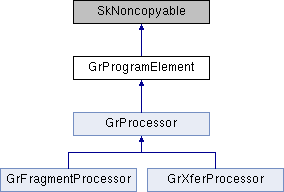|
Skia
2DGraphicsLibrary
|
|
Skia
2DGraphicsLibrary
|
Base class for GrProcessor. More...
#include <GrProgramElement.h>

Public Member Functions | |
| void | ref () const |
| void | unref () const |
| uint32_t | getUniqueID () const |
| Gets an id that is unique for this GrProgramElement object. More... | |
| void | validate () const |
Protected Member Functions | |
| void | addGpuResource (const GrGpuResourceRef *res) |
| Subclasses registers their resources using this function. More... | |
| void | addPendingExecution () const |
| void | completedExecution () const |
Private Types | |
| typedef SkNoncopyable | INHERITED |
Private Member Functions | |
| virtual void | notifyRefCntIsZero () const =0 |
| This will be called when the ref cnt is zero. More... | |
| void | removeRefs () const |
| void | addPendingIOs () const |
| void | pendingIOComplete () const |
Static Private Member Functions | |
| static uint32_t | CreateUniqueID () |
Private Attributes | |
| int32_t | fRefCnt |
| int32_t | fPendingExecutions |
| uint32_t | fUniqueID |
|
SkSTArray< 4, const GrGpuResourceRef *, true > | fGpuResources |
Friends | |
| template<typename T > | |
| class | GrPendingProgramElement |
Base class for GrProcessor.
This exists to manage transitioning a GrProcessor from being owned by a client to being scheduled for execution. While a GrProcessor is ref'ed by drawing code its GrGpu resources must also be ref'ed to prevent incorrectly recycling them through the cache. However, once the GrProcessor is baked into a GrPipeline and the drawing code has stopped ref'ing it, it's internal resources can be recycled in some cases.
We track this using two types of refs on GrProgramElement. A regular ref is owned by any client that may continue to issue draws that use the GrProgramElement. The GrPipeline owns "pending executions" instead of refs. A pending execution is cleared by ~GrPipeline().
While a GrProgramElement is ref'ed any resources it owns are also ref'ed. However, once it gets into the state where it has pending executions AND no refs then it converts its ownership of its GrGpuResources from refs to pending IOs. The pending IOs allow the cache to track when it is safe to recycle a resource even though we still have buffered GrBatches that read or write to the the resource.
To make this work all GrGpuResource objects owned by a GrProgramElement or derived classes (either directly or indirectly) must be wrapped in a GrGpuResourceRef and registered with the GrProgramElement using addGpuResource(). This allows the regular refs to be converted to pending IO events when the program element is scheduled for deferred execution.
Moreover, a GrProgramElement that in turn owns other GrProgramElements must convert its ownership of its children to pending executions when its ref count reaches zero so that the GrGpuResources owned by the children GrProgramElements are correctly converted from ownership by ref to ownership by pending IO. Any GrProgramElement hierarchy is managed by subclasses which must implement notifyRefCntIsZero() in order to convert refs of children to pending executions.
|
inlineprotected |
Subclasses registers their resources using this function.
It is assumed the GrProgramResouce is and will remain owned by the subclass and this function will retain a raw ptr. Once a GrGpuResourceRef is registered its setResource must not be called.
|
inline |
Gets an id that is unique for this GrProgramElement object.
This will never return 0.
|
privatepure virtual |
This will be called when the ref cnt is zero.
The object may or may not have pending executions.
Implemented in GrXferProcessor, and GrFragmentProcessor.